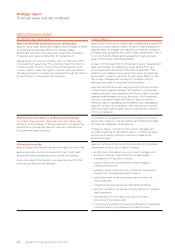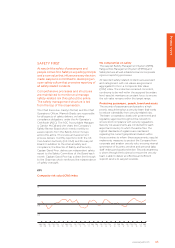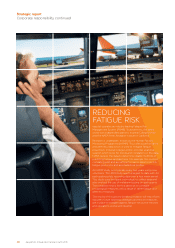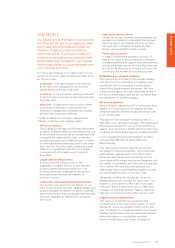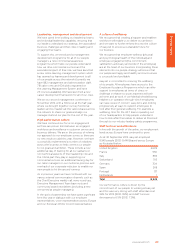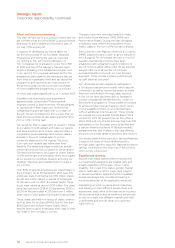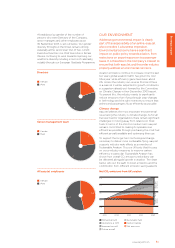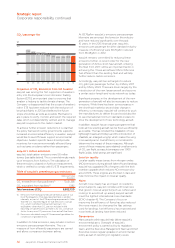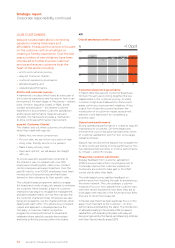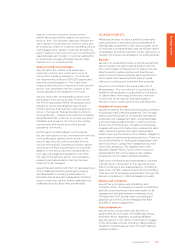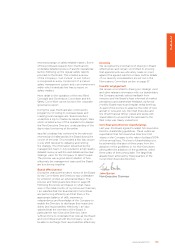EasyJet 2013 Annual Report Download - page 54
Download and view the complete annual report
Please find page 54 of the 2013 EasyJet annual report below. You can navigate through the pages in the report by either clicking on the pages listed below, or by using the keyword search tool below to find specific information within the annual report.
52 easyJet plc Annual report and accounts 2013
Strategic report
Corporate responsibility continued
Projection of CO2 Emissions from UK Aviation
easyJet was among the first supporters of aviation’s
entry into the European Union’s Emission Trading
System (ETS), an important step to ensuring that
aviation is helping to tackle climate change. The
Company is disappointed that the scope of aviation’s
role in ETS has been reduced with the exclusion of
long-haul flights in 2013 and believes the future
scope should be as wide as possible. Mechanisms
are in place to verify, monitor and report the required
data, which is independently verified, and to manage
easyJet’s exposure to the carbon market.
To achieve further emission reductions it is vital that
the policy framework set by governments supports
increased environmental efficiency in aviation. easyJet
would like to see ETS taxes support environmental
objectives. Aviation specific taxes should provide
incentives for more environmentally efficient flying
such as taxes on planes rather than passengers.
easyJet’s carbon emissions
easyJet’s total carbon emissions were 5.6 million
tonnes (see table below). This is overwhelmingly made
up of emissions from fuel burn. The calculation of
these emissions is based on fuel burn measurement,
which is verified, to comply with EU ETS requirements.
Table of easyJet’s greenhouse gas emissions
Emission total
(tonnes)
CO2 emitted from flying activities(1) 5,551,338
CO2 equivalent from facilities(2) 1,382
Total emissions (CO2) 5,552,720
(1) Emissions from flying activities are verified as part of our
EU-ETS obligations. The data reported here is verified
internally, as part of the ETS reporting requirements. Note
that the CO2 reported figure for fuel emissions is actual
CO2, which is emitted from aircraft fuel burn. CO2
equivalents other than CO2 are not included in the
reporting of fuel emissions as there is no CO2 conversion
factor for any non-CO2 emissions from aircraft fuel burn.
(2) Emissions calculated using UK Government guidelines for
conversion of grid electricity.
In addition to total emissions, easyJet also monitors
emissions per passenger kilometre. This is a
measure of how efficiently passengers are carried
and allows comparison between airlines.
At 83.76g/km easyJet’s emissions per passenger
kilometre are amongst the lowest in the industry
and have reduced significantly over the past
10 years. In the 2013 financial year, easyJet’s
emissions per passenger km (the standard industry
measure of efficiency) were 83.76g/km reduced
from 85.48g/km in 2012.
easyJet remains committed to reducing these
emissions further. A recent order for the new
generation of Airbus short-haul aircraft, entering
the fleet from 2017, will be an important factor in
achieving this. These aircraft are 13% to 15% more
fuel efficient than the existing fleet and will help
further reduce carbon emissions.
Accordingly, easyJet has set targets to reduce
CO2 g/km per passenger further, by 2.5% by 2017
and by 5% by 2022. These are driven largely by the
introduction of the new, larger aircraft and assume
a similar sector length and route network as today.
Significant progress in the development of the new
generation of aircraft will also be necessary to reduce
emissions. While there has been some progress in
the short-haul market a second step change in
efficiency is necessary. easyJet will continue to push
the manufacturers to deliver this and would also like
to see international minimum standards in place to
drive the development of new technology aircraft.
In addition, easyJet has an ongoing programme that
looks at how existing aircraft can be flown as efficiently
as possible. This has included the installation of new
lightweight seats and trolleys and the introduction of
sharklets; an enlarged wing tip which makes the wing
more aerodynamic. Fuel efficiency is monitored to
determine the impact of these measures. Although
some of these measures save relatively small amounts
of CO2 per flight, as easyJet averages over 1,000
flights a day, total savings are significant.
Local air quality
Local air quality impact arises from nitrogen oxides
(NOx) emissions during aircraft take-offs and landings.
easyJet has upgraded 61% of engines with the tech
insertion upgrade which reduces NOx emissions by
around 10%. These engines are the best in class and
help minimise the impact on local air quality.
Noise
Aircraft noise clearly has an impact on residents
around airports. easyJet complies with local rules
that govern noise at airports (such as curfews and
routings to avoid built up areas). easyJet aircraft
meet the tightest international noise standards
(ICAO chapter 4). The Company’s focus on
improving the efficiency of flying has also reduced
the noise impact; by changing the flap settings
used for landings, fuel efficiency has improved and
noise levels at landing have been reduced.
Governance
Many people within easyJet help deliver easyJet’s
environmental aims. Oversight of easyJet’s
environment policy is carried out by its regulatory
team, and the Executive Management Team and Chief
Executive receive regular updates on environmental
policy as part of reporting on regulatory issues.
CO2 / passenger Km
g
30
60
90
120
104.5
98.8
83.76
13121110090807060504
95.7
95.56
90.31
87.3 84.4
84.6
85.48


